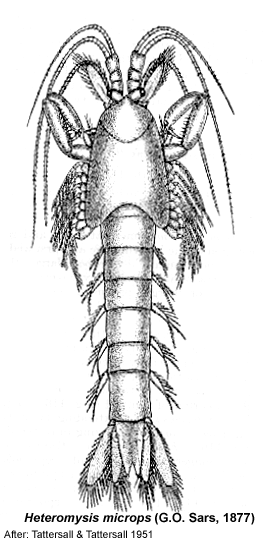 |
||||||
|
|
|
|
|
|
Mysidacea: Families, Subfamilies and TribesKenneth MelandHeteromysini Norman, 1892 Diagnostic description. Head. Carapace large, last 2 or 3 thoracic somites exposed dorsally. Rostrum broadly rounded. Eyes normally developed. Antenna (antenna 2) scale with apical suture, outer margin smooth, setose, without terminal spine. Labrum symmetric. Mandible lacinia mobilis well developed, spine row present between lacinia mobilis and molar process, molar process well developed. Thorax. 1st maxilliped exopod well developed. 2nd thoracopod developed as a maxilliped, exopod well developed. 3rd thoracopod forming a gnathopod. 3rd-8th thoracopods endopod with fused carpus and propodus (tarsus), carpopropodus divided into several subsegments. Branchiae on thoracopods absent. Marsupium composed of two pairs of oostegites (in Heteromysis the lamellae form a two compartment brood pouch). Abdomen 6th & 7th abdominal somites fused. Female pleopods uniramous or greatly reduced. Uropod endopod inner margin with robust setae, statocyst present; exopod complete, setose around entire margin. Telson apex cleft. Generic composition. Heteromysini contains 8 genera (81 species): Bermudamysis Bacescu & Iliffe, 1986 (1 species); Burrimysis Jaume & Garcia, 1993 (1 species); Deltamysis Bowman & Orsi, 1992 (1 species); Heteromysis S.I. Smith, 1873 (64 species); Heteromysoides Bacescu, 1968 (8 species); Neoheteromysis Bacecscu, 1976 (1 species); Platymysis Brattegard, 1980 (1 species); Pseudomysidetes W. Tattersall, 1936 (3 species). Remarks. The Heteromysini have a wide distribution in the temperate shallow waters of the world. The tribe has recieved several genera described from marine and anchialine caves in the Atlantic Ocean and Mediterranean Sea. Heteromysinis are easily recognized by the small oval antennal scale without spines, the derived third thoracopod where the nail bends over the dactylus forming a strong prehensile claw, and reduced male and female pleopods in the form of simple unjointed plates. Recently Bravo & Murano (1996) transferred Pseudomysidetes from the tribe Mysini to be included in the Heteromysini and recent additions to both the Heteromysis and Heteromysoides can be found in Murano (1998).
Cite this publication as: 'Meland, K. (2002 onwards). Mysidacea: Families, Subfamilies and Tribes. Version 1: 2 October 2002. https://crustacea.net'. |
|
|
|
|
|
|
|
|
|
Copyright © Australian Museum, 2002 - 2003
Australian Museum website
